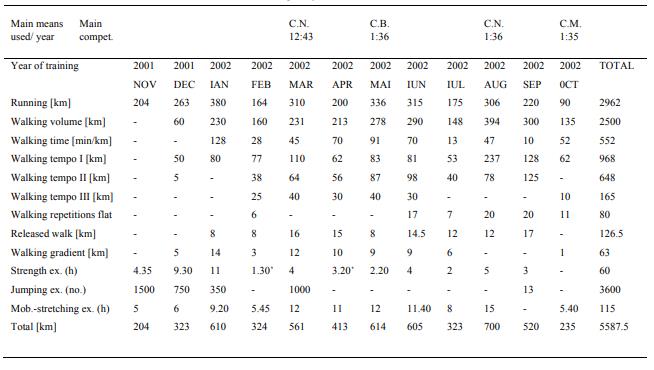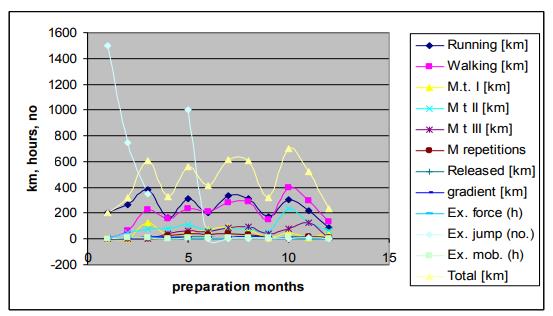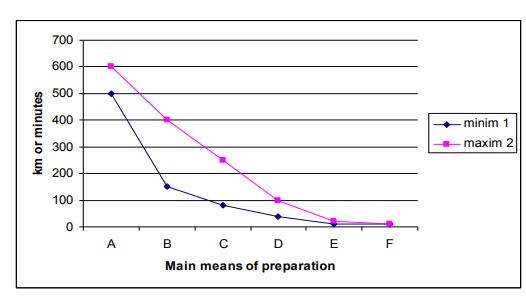Optimal Ranking of the Preparation Means in High Performance Athletic Training. Preparatory Elements
Abstract
This study presents a ranking scheme of the preparation means of the high performance athletic training, of optimizing the work scheme by applying the Taguchi technique and checking the optimal conditions to apply it. Experiment method is used with a single subject, C.D., a member of the national race walking team of Romania. The purpose of the study was to determine the preparation characteristics for this athlete, under the circumstances of applying a model designed according to the Taguchi technique and through assessing the benefits of this technique, which should allow its application to the other members of the team as well. The issue of this study is a vast one, so it has been structured in two parts that are presented in two papers separately. Thus, the first paper reveals the reasons for choosing this technique and the way it is used within the athletic training. The athletic training is regarded as a system upon which more disturbing factors activate. The Taguchi technique is the only approach that allows the optimization of the system within the real context, when the factors activate, the technique being appropriate for the athletic activity when these factors cannot be eliminated. The custom training schemes for C.D. were designed and then these schemes were graphically transposed explicitly and unitarily in order to implement the technique. The experimental training model was constructed and the training sessions were conducted according to the requirements.
Keywords: Experimental model, Taguchi, ranking, implementation
1. Introduction
In order to justify the decision to use the Taguchi technique within the training sessions of race
walking athletes, some theoretical indications are necessary regarding the research means that can be
approached through this technique.
The Taguchi technique can be used to improve the athletes’ training sessions. Although nowadays it
is mostly applied for the optimization of industrial processes and products, the availability of the
technique is wider (Alexis, 1999). The technique is rather easy to use, it is not expensive, and does not
require thorough calculations. It allows the identification of the process parameters, which ensures the
optimization of a certain system, thus, within a training session, it allows setting the most effective
training means.
Usually, when there is dispersal or instability of the functioning characteristics of a system, one
must search for the causes in order to reduce or eliminate them (Everrett, Adam; & Ebert, 2001). These
causes may be multiple, according to the nature of the system, in our case the athlete:
external causes: social causes, adversaries, referees, regulations, competition system; internal causes: health, high physical and psychological effort, coach-athlete relationship,
psychological state, motivation, emotional state (Damilano, 1994).
The Taguchi strategy consists in identifying the mixtures of training techniques which reduce the
effects of the disturbing causes, without these being directly attacked (Alexis, 1999).
The parameters that can be easily acted upon are called. The finding of good
values attributed to the controlled factors is achieved experimentally, with the purpose of optimizing
the system. Thus, with little expense, the purpose is that the optimized system – the training of the
athletes – is reached through the Taguchi technique, so it:
respects the performance goals; is robust, resistant to disturbing factors.
The attempts to improve the results of an athlete are part of the objectives of a coach, who studies
the parameters which define the training of the athlete with the purpose of obtaining the performance
set. When trying to achieve progress in the training process, one or more workouts are to be altered,
which can be represented by one or more numbers of sessions. Thus, things start to become more
complicated.
The logical process is an attempt to alter training only once – for instance, changing the walking
volume in tempo 1. Each new attempt derives from the conclusions of the previous attempts. There is
no way one could tell beforehand how many attempts are necessary and if the results are as expected.
It is likely for one to achieve optimal results with minimal expense using the fractional factorial
orthogonal background designs.
A scheme of experiences contains a series of trials organized beforehand to determine the possible
influences of various parameters, with a minimum number of trials and maximum accuracy, in order to
optimize the performances of the studied system (the athlete’s training).
One of the major contributions of the Taguchi technique to implementing the techniques of the
background plans is that of simplifying these particular plans and offering a collection of standard
plans, allowing their quick adaptation to the actual needs. A big part of the statistical issues have been
simplified or eliminated. Therefore, now all the specialists and non-specialists are able to design
background plans and use them as well.
The walker’s training, considered as a system, is affected by certain disturbing factors (α, β, … , φ)
called (fatigue, stress, personal issues, bad environmental conditions, profile of the track where
the training takes place). Noises may have manageable or random values. Classical approaches imply
the elimination of noises in order to optimize the system, but within the training session these
disturbing factors cannot be eliminated.
The Taguchi technique is the only approach that allows the optimization of the system within the
real context where the disturbing factors are present, thus being appropriate for the athletic activity
where the disturbing factors cannot be eliminated (strong wind during competition or training).
Through the signal/noise (S/N) ratio, the influence of the disturbing factors on the system’s outcome is
being marked out (Alexis, 1999).
Thus, the athletes’ performances may represent optimization criteria. These criteria come in three
shapes: decreasing (e.g. the travel time of a distance in walking), increasing (e.g. the distance at which
an athlete throws the javelin), or target criteria (e.g. hitting the centre of the target in shooting events).
In an athlete’s training, more optimization criteria can be met. For instance, a race walking athlete can
improve his/her time in an event (decreasing criteria), his/her body weight (target criteria, if the body
weight must have the same value), and the effort volume, representing increasing criteria (Beju, 2002).
2. Materials and methods
The purpose of this study is to determine the characteristics of the training technique for the athlete
C.D., which could later allow the application of a Taguchi-based model. The intention was that the
research should try to solve the issues related to the use of certain integrated information systems and
to the advantages that come with them in preparing the race walking event and training session for
making them more efficient. The technique is relatively easy to use, it is not expensive, and does not
require laborious calculations.
For the purposes of the research approach, it was used longitudinal observation (tracking the
athlete’s behaviour and evolution during training and competition), in order to gather data and
information on previous training of the athlete over a long enough period. Thus, we resorted to direct,
natural observation made under normal conditions, which aimed to capture some aspects regarding the
athlete’s general behaviour and the high performance race walking conditions and specific activities
(environment, training place, interpersonal relationships, recovery programs).
The places where the experiment took place were the training facilities of the Romanian Athletics
Federation, meaning Băile Felix, Poiana Brașov, Piatra Arsă, Bucharest and then Sibiu. It must be
mentioned that the training sessions were mainly performed on the driveway, with small exceptions.
Thus, in Piatra Arsă, the existing conditions dictated that the training sessions should take place on the
tartan track of the stadium; the strength and motility exercises were carried out in specially set halls in
the mentioned locations.
Besides the necessary equipment used by the athlete during training (gym, outfit, electronic timer
for recording the exact time in the trials, etc.), throughout the entire research other facilities were also
used. We are talking mainly about the components of the informational system used in the acquisition
and processing of the data obtained from the competition and training monitoring. The components of
the informational system (audio-video and IT) used were the following: recording camera, VCR, TV
set, PC, laptop, printer, internet connection, specific hardware, software components (Auto Cad, MS
Excel, etc.), USB-6008 data acquisition system from National Instruments.
For processing, interpreting and presenting the results, special software was used (Excel and SPSS).
For the graphical part, we used the Auto Cad program, Microsoft Word - XP running under Windows
XP Professional, which has a great manageability in creating tables and informational system schemes.
Table 1 presents information on the athlete who participates in the experiment (personal data, best
career performance, as well as life activity results).

It must be mentioned that C.D. was the subject of the experiment, an athlete whom we prepared
from the moment of selection up to reaching a high performance level, as to take part in major
international competitions. Training sessions and competitions in which the athlete participated
between 2000-2001, 2001-2002, 2002-2003 were recorded and analysed, then the Taguchi technique
was introduced in the training program in 2003-2004. The main condition that a coach must meet to
apply this method is systematic recording of daily training, what has been done and is presented below.
3. Results
The research was structured in two stages: the preparation stage and the experimental stage. This
paper presents only the preparatory experiment, the latter being presented in a second paper. During
2000-2003, the custom training plans for C.D. were designed. Then, the plans were graphically
transcribed in an explicit and unitary manner in order to apply the Taguchi technique during the
following training season, 2003-2004. The preparatory stage contained the following phases:
- Daily recording of training and implementation of training plans for C.D. during 2000-2003.
- Transposition of training plans in an explicit and unified graphical form in order to enable the
implementation of Taguchi method in the preparation of the athlete during the next year, 2003-2004.
- Processing and analysing the data obtained from the experiment.
- Setting the main means of preparation to be used by C.D. in the athletic training (Factors A, B, C,
D, E, F) and their limit values denoted by indices 1 - minimum and 2 - maximum.
- Conclusions on preliminary phase of the experiment.
As the necessity arose to have a unitary vision of the athlete’s training characteristics, the recording
of daily training sessions took place from October 2000 until August 2004, and then their monthly
number was expressed in the measurement scales specific to each test. There were mentioned the
performances achieved in the most important competitions that took place in each studied year.
The next step was to move the information about the training sessions into a table, an operation
which could give an explicit and quick perspective. Table 2 presents the data recorded in the training
year 2001-2002, and each year of preparation shows as follows:

Data are represented in graphical form as shown in Figure 1.

The information took from these tables served as a starting point in creating a model for establishing
the working volumes specific to each training technique. The main means of preparation used in the
athletic training for C.D. (Factors A, B, C, D, E, F) and their limit values denoted by indices 1 and 2
are:
A = Total miles travelled (running + walking) (A1 = 500 km/ month, A2 = 600 km/ month); B = VM - total miles travelled in walk, (B1 = 150 km/ month, B2 = 400 km/ month); C = MT1 - km walk tempo (5'30"/ km - 5'05"/ km) (C1 = 80 km/ month, C2 = 250 km/ month); D = MT2 - km walk tempo 2 (under 5'/ km) (D1 = 40 km/ month, D2 = 100 km/ month); E = power exercises [min] (E1 = 10 min/ day E2 = 20 min/ day); F = stretching exercises - mobility [min] (F1 = 10 min/ day, F2 = 20 min/ day).
Index 1 represents the minimum volume and index 2 is the maximum value which can be assigned
to a means of preparation. Further, these data are presented in tabular form (Table 3) and graphical
form (Fig. 2).

4. Discussions and conclusions
Following the preparation of the experiment, we can outline that:
The early stages of research have been determined and then clarified to be better understood, and
new opportunities have been provided for the experienced success responsiveness. Taguchi method is a
unique tool in preparing athletes from various sports and can be a research tool to boost the
performance of athletes and the scientific validity of their training with minimum cost and maximum
performance.
There have been defined optimization experiments for the researched athlete. The results are only
valid for her and can form the basis for her future training. Extending the approach to other sports in
the same sample may reveal common elements that would become standard practice in the
management of future training.
During the research, we worked with a number of specialists in sports training and in other fields,
among which we mention the following:
coaches of the other components of the national race walking team, who have expressed their desire
to use this method in preparing athletes;
federal coaches of the middle-distance, long-distance and walking races;
academics, engineers - specialists in computer science and in mechanics;
specialists in sports medicine.
The proper preparation of an experiment has a major influence over its results. Therefore, the
preparation activity was laborious, especially because the training plans were developed for more
years, they had to be supervised closely and also to provide more versions which could be analysed and
used within the context of the model:
After the preparation stage, there have been obtained the following:
The limit values of the main means of training presented in tabular form (Table 3) and graphically (Fig. 2). These data will be included in next year’s training plan.
The grounds of the experimental model for training C.D., based on the Taguchi technique. The processing, interpretation and analysis of the data resulted from the experiment, as well as the
conclusions drawn regarding the experiment, will be presented in a second paper.
References
Alexis, J. (1999). Metoda Taguchi. Planuri de experienţe. București: Editura Tehnică.
Beju, L. (2002). Bazele teoriei sistemelor. Sibiu: Editura Universităţii “Lucian Blaga”.
Damilano, S. (1994). La marcia. Scienza & TecnicaAtleticastudi, 6, 113-119.
Everrett, E., Adam, Jr., & Ebert, R. J. (2001). Managementul producţiei şi al operaţiunilor. București: Teora.
Copyright information

This work is licensed under a Creative Commons Attribution-NonCommercial-NoDerivatives 4.0 International License.
About this article
Publication Date
10 June 2016
Article Doi
eBook ISBN
978-1-80296-010-5
Publisher
Future Academy
Volume
11
Print ISBN (optional)
-
Edition Number
1st Edition
Pages
1-509
Subjects
Sports, sport science, physical education
Cite this article as:
Badescu, D. (2016). Optimal Ranking of the Preparation Means in High Performance Athletic Training. Preparatory Elements . In V. Grigore, M. Stanescu, & M. Paunescu (Eds.), Physical Education, Sport and Kinetotherapy - ICPESK 2015, vol 11. European Proceedings of Social and Behavioural Sciences (pp. 313-319). Future Academy. https://doi.org/10.15405/epsbs.2016.06.43

